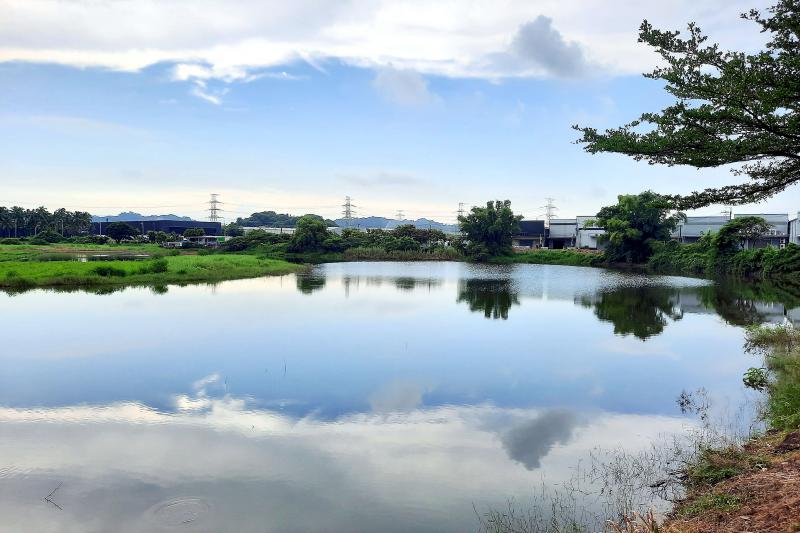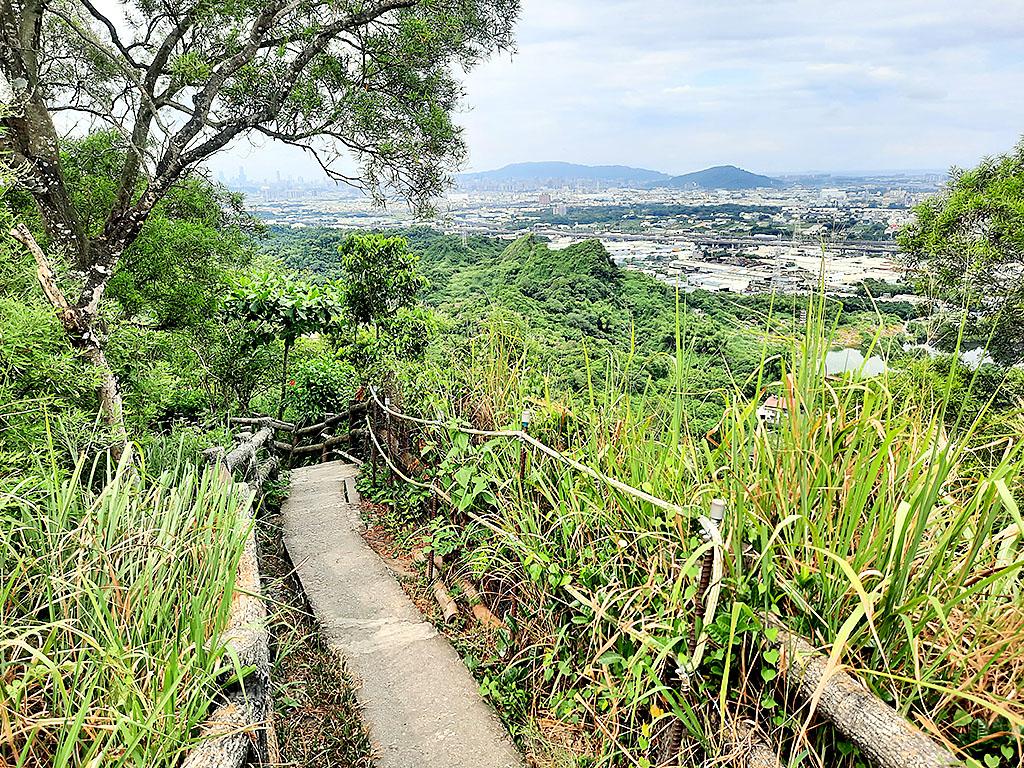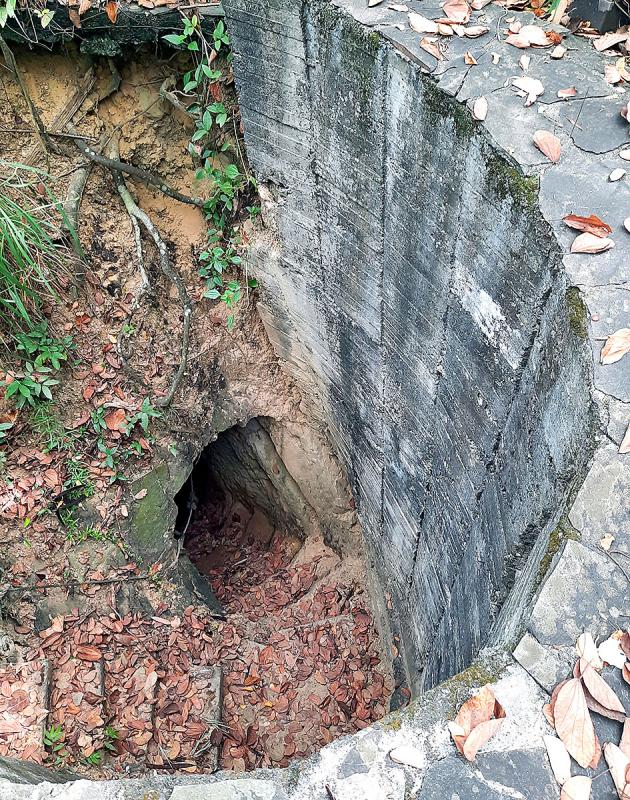By the vertiginous standards of Taiwan’s interior, Guanyin Mountain (觀音山) — which straddles Kaohsiung’s Dashe (大社) and Renwu (仁武) districts — is a micro-mountain. Judged purely on its height, it wouldn’t deserve a paragraph.
The summit is just 177m above sea level, making it one of the shortest of xiaobaiyue (小百岳, “Taiwan’s Little Hundred Mountains”). But in terms of how far you can see from the top, and for how little exertion, Guanyin Mountain is entitled to some kind of accolade.
The day had begun with a rush-hour motorcycle ride through bleak industrial neighborhoods. My mood improved as soon as I reached Guanyin Lake (觀音湖), a 17-hectare body of water about 3km south of Guanyin Mountain. While egrets pecked at the mud, a few humans exercised on the path that hugs the lake’s eastern shore.

Photo: Steven Crook
Like the nearby hill, Guanyin Lake is named for the Buddhist goddess of mercy. In the Indian subcontinent, where she’s a he, Guanyin is known as Avalokitesvara.
From the lake, I rode past bamboo groves, little shrines and clusters of graves to Yancheng Lane (鹽埕巷), site of the main trailhead for Guanyin Mountain. The local government has marked out plenty of parking spots for cars and motorcycles, but the brand-new bathrooms aren’t yet open to the public. The bilingual mapboard will help you get your bearings.
The first section of trail is as wide as a road. It ascends to Gaosuwei Rest Stop (高速尾休息站), where there’s a pavilion and some benches.

Photo: Steven Crook
I had three options. I could go straight on and follow a broad concrete track down into thick woodland. On the right, knotted ropes led up a very steep hillside. On the left, where a sign pointed to the Sky Cave (天洞), the gradient was less intimidating.
I didn’t see any reason to go downhill, and without gloves I didn’t fancy ropework. Several other people were heading up or emerging from the Sky Cave route, so I took a swig of water, mopped my face and hiked in that direction.
Just 20 minutes after locking my motorcycle, I was standing on a wooden platform that adds a tiny bit of height to Guanyin Mountain’s summit. From it, I could recognize 85 Sky Tower (高雄85大樓), Taiwan’s tallest building when it was completed in 1997, to the southwest. To the northwest, the distinctive flue-gas stacks of Hsingta Power Plant (興達發電廠) were visible through the haze. Most of Kaohsiung’s population of 2.72 million lives between these two landmarks.

Photo: Steven Crook
I won’t pretend that the southern city is a beautiful metropolis, but I was genuinely impressed by what and how much I could see. In addition to the high-speed railway, Freeway 1 and natural features like Banping Mountain (半屏山), I counted five cargo ships in the Taiwan Strait.
For decades, the Sky Cave (which is just beyond the summit if you’re coming from Gaosuwei Rest Stop) was thought to be a natural cave. Only last year did researchers conclude that it was carved from the bedrock by the Imperial Japanese Army during World War II, presumably to serve as an air raid shelter. It’s said to be about 20m long, and no barrier prevents the adventurous from taking a look inside.
July mornings are always warm, and the day was unconscionably humid to boot. I’d not got far beyond the Sky Cave before my shirt was drenched. As I moved along the ridge, a rain of sweatdrops fell from my brow. Worried that I’d exhaust my water and end up far from my motorcycle, I returned to Gaosuwei Rest Stop.

Photo: Steven Crook
After a breather, I set off on the downhill path toward the Acacia Forest (相思林). This turned out to be easy hiking — no challenging gradients, plenty of shade and a one-way distance of just under 600m.
I didn’t spend long in the forest. It isn’t spectacular, and I couldn’t stop thinking about the large and strikingly blue building I’d seen earlier from the ridge near the Sky Cave. I couldn’t be sure, given the distance, but from its shape I guessed it might be a temple.
A quick online search turned up nothing, so I motorcycled east along Road 186A (186甲). And near the Chen Family Graveyard (陳氏墓園) — among those buried here is the mother of Chen Chi-chuan (陳啟川), mayor of Kaohsiung from 1960 to 1968 — I found what I’d been searching for.
It’s a religious institution in the Chinese tradition. That much is obvious from the crane, dragon and swastika motifs. But while temples located off major roads tend to announce their presence with a monumental gateway, here I didn’t see a signpost, or even a name at the front of the building.
Beside the compound, concrete steps go up the hill. I followed them in the hope there’d be a back entrance to the property, the main doorway being emphatically shut.
These steps, I learned from a signpost, exist so hikers can scramble to the top of Luotuo Mountain (駱駝山, “Camel Mountain”). According to that sign, it takes 23 minutes to cover the 856m from the end of the steps to the top of that hill. Hiking blogs say it’s possible to continue beyond Luotuo Mountain and loop back to Guanyin Mountain.
Returning to the parking lot, I hunted around for another way in. One gate was padlocked, and a workman retouching exterior paintwork ignored me. So close but none the wiser, I thought.
Later, I discovered that the name of this oddity may be Wuji Guanyin Temple (無極觀音寺). However, a Kaohsiung telephone number associated with that name proved to be a dead end.
A temple that couldn’t make itself more eye-catching if it tried, but which otherwise does absolutely nothing to alert the outside world to its existence. Perhaps the people who worship here don’t want anyone to know about their sect. It’s like they’ve found a secret, and they don’t wish to share it.
Steven Crook has been writing about travel, culture and business in Taiwan since 1996. He is the author of Taiwan: The Bradt Travel Guide and co-author of A Culinary History of Taipei: Beyond Pork and Ponlai.

“Why does Taiwan identity decline?”a group of researchers lead by University of Nevada political scientist Austin Wang (王宏恩) asked in a recent paper. After all, it is not difficult to explain the rise in Taiwanese identity after the early 1990s. But no model predicted its decline during the 2016-2018 period, they say. After testing various alternative explanations, Wang et al argue that the fall-off in Taiwanese identity during that period is related to voter hedging based on the performance of the Democratic Progressive Party (DPP). Since the DPP is perceived as the guardian of Taiwan identity, when it performs well,

The Taiwan People’s Party (TPP) on May 18 held a rally in Taichung to mark the anniversary of President William Lai’s (賴清德) inauguration on May 20. The title of the rally could be loosely translated to “May 18 recall fraudulent goods” (518退貨ㄌㄨㄚˋ!). Unlike in English, where the terms are the same, “recall” (退貨) in this context refers to product recalls due to damaged, defective or fraudulent merchandise, not the political recalls (罷免) currently dominating the headlines. I attended the rally to determine if the impression was correct that the TPP under party Chairman Huang Kuo-Chang (黃國昌) had little of a

At Computex 2025, Nvidia CEO Jensen Huang (黃仁勳) urged the government to subsidize AI. “All schools in Taiwan must integrate AI into their curricula,” he declared. A few months earlier, he said, “If I were a student today, I’d immediately start using tools like ChatGPT, Gemini Pro and Grok to learn, write and accelerate my thinking.” Huang sees the AI-bullet train leaving the station. And as one of its drivers, he’s worried about youth not getting on board — bad for their careers, and bad for his workforce. As a semiconductor supply-chain powerhouse and AI hub wannabe, Taiwan is seeing

Jade Mountain (玉山) — Taiwan’s highest peak — is the ultimate goal for those attempting a through-hike of the Mountains to Sea National Greenway (山海圳國家綠道), and that’s precisely where we’re headed in this final installment of a quartet of articles covering the Greenway. Picking up the trail at the Tsou tribal villages of Dabang and Tefuye, it’s worth stocking up on provisions before setting off, since — aside from the scant offerings available on the mountain’s Dongpu Lodge (東埔山莊) and Paiyun Lodge’s (排雲山莊) meal service — there’s nowhere to get food from here on out. TEFUYE HISTORIC TRAIL The journey recommences with